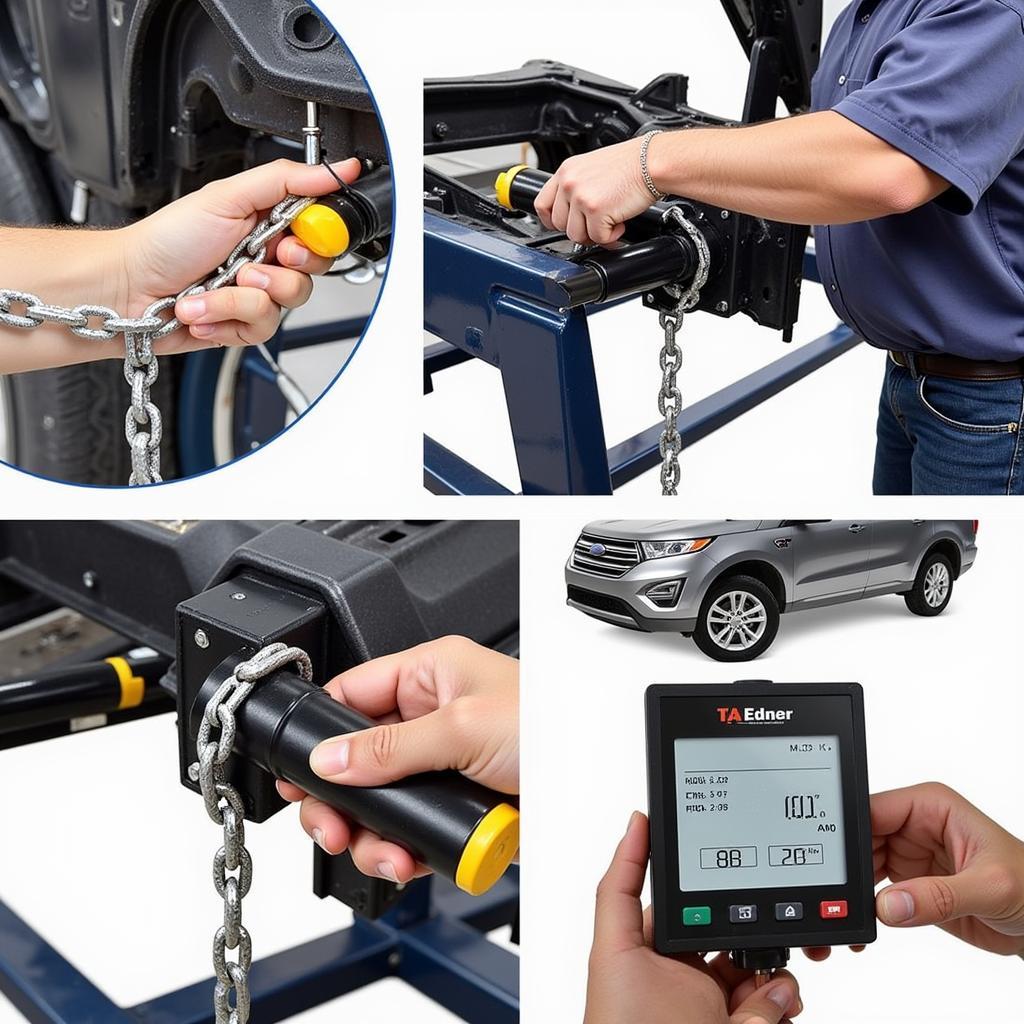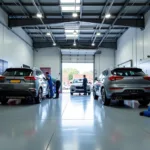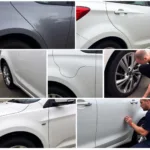A car body repair puller station is essential for restoring a vehicle’s frame after an accident. It provides the controlled force needed to straighten bent metal, returning your car to its pre-accident condition. Understanding its functions and how to effectively utilize one is key for any serious body repair shop.
Understanding the Car Body Repair Puller Station
Car body repair puller stations, sometimes called frame machines, are complex systems designed to address various forms of vehicle damage. They utilize hydraulics and chains to apply precise pulling force, allowing technicians to reshape the vehicle’s frame and chassis. From minor dents to major collision damage, these stations offer a versatile solution for a range of repairs. Choosing the right puller station depends on factors like the size of your workshop, the types of vehicles you service, and your budget.
Choosing the right puller station for your needs is crucial. Factors to consider include the station’s pulling capacity, available accessories, and ease of use.
Types of Car Body Repair Puller Stations
There are several types of puller stations available, each designed for specific needs and budgets.
- Floor-mounted puller stations: These are the most common type, offering a stable and powerful platform for pulling operations.
- Portable puller stations: Smaller and more mobile, these units are ideal for smaller shops or for use on-site.
- Bench-mounted puller stations: These are smaller units, typically used for lighter repairs or for specific components.
Essential Components of a Puller Station
A typical car body repair puller station includes several key components:
- Frame Machine: The main structure provides a solid anchor point for pulling operations.
- Hydraulic System: Generates the necessary force for straightening the frame.
- Chains and Clamps: Secure the vehicle and distribute the pulling force evenly.
- Pulling Attachments: Specialized tools for different pulling scenarios.
- Measuring System: Accurately assesses the extent of damage and tracks the straightening progress.
Understanding each component’s function is critical for safe and effective operation.
Safety Precautions When Using a Puller Station
Safety should always be the top priority when operating a car body repair puller station.
- Wear appropriate safety gear: This includes eye protection, gloves, and steel-toed boots.
- Inspect equipment regularly: Check for wear and tear on chains, clamps, and hydraulic lines.
- Follow manufacturer’s instructions: Adhere to the recommended operating procedures.
- Ensure proper ventilation: Hydraulic fluid can produce fumes, so adequate ventilation is crucial.
How to Use a Car Body Repair Puller Station
Using a puller station effectively requires skill and precision. The process typically involves:
- Assessing the Damage: Identify the extent and location of the damage.
- Securing the Vehicle: Properly secure the vehicle to the frame machine.
- Attaching Chains and Clamps: Connect the chains and clamps to strategic points on the damaged area.
- Applying Pulling Force: Gradually apply hydraulic pressure to straighten the frame.
- Monitoring the Process: Continuously monitor the straightening process and adjust the pulling force as needed.
 Using a Car Body Repair Puller Station Precision and patience are key to achieving optimal results.
Using a Car Body Repair Puller Station Precision and patience are key to achieving optimal results.
“A well-maintained and properly used car body repair puller station is a crucial tool for any serious collision repair facility,” says John Smith, Lead Collision Repair Technician at Acme Auto Body. “It allows us to restore vehicles to their pre-accident condition with accuracy and efficiency.” He adds, “Investing in quality equipment and proper training is essential for delivering top-notch repairs.”
Conclusion
A car body repair puller station is a vital piece of equipment for any auto body repair shop. Understanding its components, operation, and safety precautions is crucial for achieving professional-grade repairs. By mastering the use of a puller station, you can effectively restore vehicles to their pre-accident condition, ensuring both safety and customer satisfaction.
FAQ
- What is the average cost of a car body repair puller station? The cost varies depending on the type and features, ranging from a few thousand dollars for portable units to tens of thousands for larger, more advanced systems.
- What type of training is required to operate a puller station? Formal training is highly recommended to ensure safe and effective operation. Many vocational schools and equipment manufacturers offer specialized training programs.
- How often should a puller station be inspected? Regular inspections, at least annually, are essential to maintain safety and performance.
- What are the common mistakes to avoid when using a puller station? Applying too much force, improper anchoring, and neglecting safety precautions are common mistakes that can lead to further damage.
- What are the alternatives to using a puller station? For minor dents and damage, techniques like paintless dent repair (PDR) might be suitable. However, for structural damage, a puller station is often necessary.
- How do I choose the right puller station for my shop? Consider the size of your workshop, the types of vehicles you service, your budget, and the available features.
- Where can I purchase a car body repair puller station? Automotive equipment suppliers and manufacturers offer a wide range of puller stations.
For further assistance, please contact us via WhatsApp: +1(641)206-8880, or Email: [email protected]. We have a 24/7 customer service team available to help.


